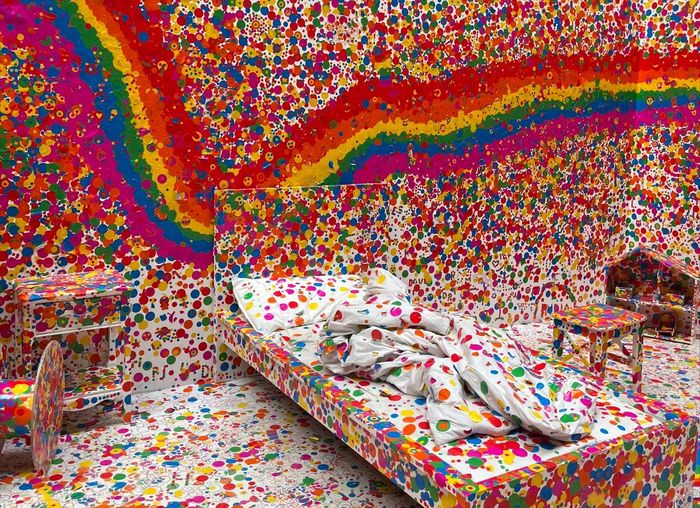Yayoi Kusama’s Infinity Mirror Rooms: a place for endless selfies or self-obliteration?
Grace Cobb questions whether the obsession with the exhibition’s “Instagrammable” aesthetic detracts from the true story it reflects for its visitors

Even as I step off my train at London Bridge to visit the Tate Modern’s highly popular and endlessly extended headline exhibition - Yayoi Kusama’s “Infinity Mirror Rooms” - I’m not entirely sure what I’m about to see. Despite scrambling to my laptop on the day further dates were released, desperately refreshing the Tate’s website until I triumphantly seized a slot, all I knew was that a summer’s worth of tickets were selling out within seconds, and had only glimpsed a few snippets of rainbow bulbs and blurry black backgrounds on Instagram. Shallowly, that was all I needed to decide I had to see the spectacle for myself.
“My breath is truly taken away as the doors click shut and I confront myself not only reflected, but refracted, transformed and shattered by the maze of endless mirrors”
As I step inside the first room - titled “Chandelier of Grief” for its representation of simultaneous beauty and sadness - I start to realise what the hype is all about. My breath is truly taken away as the doors click shut and I confront myself not only reflected, but refracted, transformed and shattered by the maze of endless mirrors. Space and time feel distorted in this tardis-like box; I peer at projections of my fellow visitors who appear miles away, stepping forward to find them mere centimetres in front of me. Only a single, spinning chandelier flickers ominously in the centre, yet the space is lit up with endless crystal shards and glimmers of electric light; whichever direction you look, the rippling multiplication of every movement, every shape, is inescapable.
The main event of the exhibition, catchily titled “Infinity Mirrored Room - Filled with the Brilliance of Life”, is even more immersive, inviting you to share in the “self-obliteration” of Kusama’s own hallucinations by engulfing you in a myriad of floating rainbow lights. Wandering through a meandering path moated by glassy strips of water, every turn of the head discovers another reflective surface to engulf you; discerning between reality and optical deception becomes impossible as the colourful bulbs blend, blur, and plunge you into disorienting darkness.
While it’s strangely easy to get lost in such a tiny space, the magical immersion in this dizzying spectacle of creative ingenuity is slightly curtailed by the sharp voice cutting through the hypnotic daze which tells you your time is up; two minutes has never felt so short. This does somewhat fulfil the room’s description that “even while we experience Kusama’s infinite space, we are made aware of time passing”. However, the exhibition’s potential to be fully absorbed and appreciated by every visitor seems to have been sacrificed in the face of its crippling popularity, with a brutally swift turnaround ensuring you’re marched out of each room only moments after stepping inside.
Ranging from young families and teenage couples to elderly friends, the diversity of viewers drawn to the experience testified to both the accessibility of such playful, interactive pieces, and the success of social media hype in bringing a huge variety of new visitors to the gallery. However, as I pored over the documentaries, short films, photographs and descriptions accompanying the rooms, the saturation of Instagram with selfies backgrounded by Kusama’s work slowly seemed to have flattened the product of pain, turmoil and ascetic diligence into simply an aesthetic optical illusion.
“The obsession with endlessly exploiting her “Instagrammable” artistic visions verges on appropriating Kusama’s painstaking artistry”
Documented in the short films “Walking Piece” and “In the studio” - which depict her bold resistance towards the sexism and racism she faced, satirising the stereotypes of Japanese women in America which threatened to restrict her - it’s clear Kusama’s powerful and absurd art is both therapy for, and testament to, a lifetime of trauma. However, the obsession with endlessly exploiting her “Instagrammable” artistic visions verges on appropriating Kusama’s painstaking artistry and technique, potentially falling into a familiar storylines of Western exoticisation of Japanese culture, and society’s habit of gleefully extracting the products of severe mental illness while ignoring their origins.
From a distressing, restricted childhood in Tokyo which triggered hallucinations and obsessive fears, to watching her work shamelessly stolen by male counterparts like Andy Warhol and Claes Oldenburg, Kusama’s life has been one of endless adversity. With her relationship with mental illness constantly teetering between fuelling her artistry and driving her to multiple suicide attempts, permanent residence in a psychiatric hospital has now become the only way she can safely continue to create.
While I’m not entirely convinced I saw grief reflected back in the white electric light of the chandelier, or completely disappeared among floating dots in the room of infinite mirrors, the chance to immerse myself in the story of such a unique artist ended up being the real highlight of the exhibit. I only hope that its staggering popularity widens the circle of people given the chance to reflect on the infinite depth of this woman’s incredibly creative mind, rather than simply seize the chance to jump on a trend and use her as the background for their next post.
 Features / Should I stay or should I go? Cambridge students and alumni reflect on how their memories stay with them15 December 2025
Features / Should I stay or should I go? Cambridge students and alumni reflect on how their memories stay with them15 December 2025 News / Cambridge study finds students learn better with notes than AI13 December 2025
News / Cambridge study finds students learn better with notes than AI13 December 2025 Comment / The magic of an eight-week term15 December 2025
Comment / The magic of an eight-week term15 December 2025 News / News In Brief: Michaelmas marriages, monogamous mammals, and messaging manipulation15 December 2025
News / News In Brief: Michaelmas marriages, monogamous mammals, and messaging manipulation15 December 2025 News / Uni Scout and Guide Club affirms trans inclusion 12 December 2025
News / Uni Scout and Guide Club affirms trans inclusion 12 December 2025










